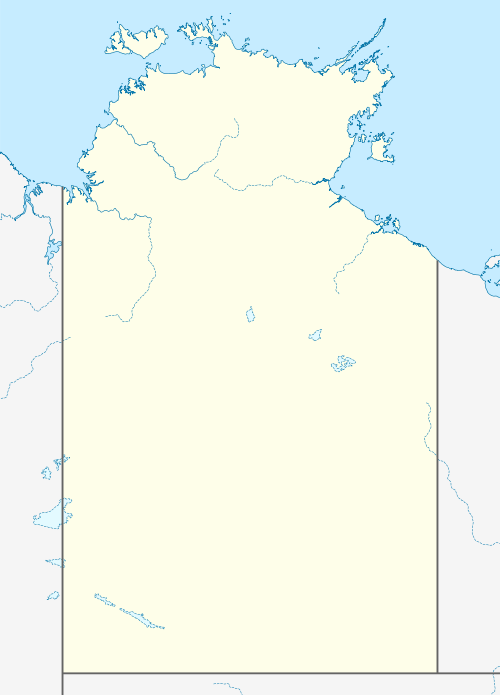Kintore, Northern Territory
Kintore (Pintupi: Walungurru) is a remote settlement in the Kintore Range of the Northern Territory of Australia about 530 km (330 mi) west of Alice Springs and 40 km (25 mi) from the border with Western Australia. At the 2016 census, Kintore had a population of 410, of which 376 (91.9 per cent) identified themselves as Aboriginal Australians.[2]
| Kintore Walungurru Northern Territory | |||||||||||||||
|---|---|---|---|---|---|---|---|---|---|---|---|---|---|---|---|
 Kintore Walungurru | |||||||||||||||
| Coordinates | 23°16′25″S 129°22′55″E[1] | ||||||||||||||
| Population | 410 (2016 census)[2] | ||||||||||||||
| • Density | 50.0/km2 (129.5/sq mi) | ||||||||||||||
| Established | 1981 | ||||||||||||||
| Postcode(s) | 0872[3] | ||||||||||||||
| Elevation | 454 m (1,490 ft)(weather station)[4] | ||||||||||||||
| Area | 8.2 km2 (3.2 sq mi)[5] | ||||||||||||||
| Time zone | ACST (UTC+9:30) | ||||||||||||||
| Location |
| ||||||||||||||
| LGA(s) | MacDonnell Region[1] | ||||||||||||||
| Territory electorate(s) | Namatjira | ||||||||||||||
| Federal Division(s) | Lingiari | ||||||||||||||
| |||||||||||||||
| |||||||||||||||
| Footnotes | Locations[3] Adjoining localities[6][lower-alpha 1] | ||||||||||||||
The Kintore Range was named by William Tietkens during his expedition of 1889 after the Governor of South Australia, Algernon Keith-Falconer, 9th Earl of Kintore.[8]
In 1979 and 1980 satisfactory water was found in four bores sunk at and near the Kintore Range. In mid-1981 an outstation was established there and developed as a resource centre for camps elsewhere in the region, allowing the reoccupation of at least some of the Pintupi country.[8]
The community was founded in 1981, when many Pintupi people who lived in the community of Papunya (about 240 km (150 mi) from Alice Springs) became unhappy with their circumstances in what they saw as foreign country, and decided to move back to their own country, from which they had been forcibly removed decades earlier due to weapons testing from Woomera in South Australia, as part of the outstation movement.
Kintore is overseen by the MacDonnell Regional Council,[1] which is based in Alice Springs. The community also has a NT Government funded primary school, an independent store trading as Puli Kutjarra (meaning Two Rocks/mountains in Pintupi language), an airstrip, an independent health clinic called Pintupi Homelands Health Service, a women's centre called Ngintaka Women's Centre, haemodialysis at The Purple House run by Western Desert Dialysis,[9] a high school run by Yirara College,[10] and an arts centre run by Papunya Tula Artists Pty. Ltd. The town is in the territory electorate of Namatjira and the federal electorate of Lingiari.
Kintore is a major centre for the Western Desert art movement which began at the community of Papunya. These people traditionally passed on significant Dreamtime stories by way of art using sand, rock and local plants. Nowadays such paintings are done on canvas and have gained worldwide popularity. A number of members of the famous Aboriginal art company Papunya Tula live at Kintore.
In Pintupi, the majority language of the community, Kintore is known as Walungurru (pronounced [ˈwɐɭʊŋʊɾʊ]).
Kintore is mentioned in the Midnight Oil song "Beds are Burning" (from the Diesel and Dust album): "Four wheels scare the cockatoos/From Kintore east to Yuendumu".
The local Australian rules football team is the Walungurru Hawks. Yellow and brown paint, also the colours of Hawthorn AFL team, feature heavily on houses and businesses in the community.
References
- "Search results for 'Petermann (Locality)'". NT Place Names Register. Northern Territory Government. Retrieved 20 January 2020.
- Australian Bureau of Statistics (27 June 2017). "Kintore (State Suburb)". 2016 Census QuickStats.

- "Kintore Postcode". postcode-finders.com.au. Retrieved 18 January 2020.
- "Monthly climate statistics: Summary Walungurru Airport (nearest weather station)". Commonwealth of Australia , Bureau of Meteorology. Retrieved 13 January 2020.
- "Kintore". Australias Guide Pty Ltd. Retrieved 18 January 2020.
- "Kintore". NT Atlas and Spatial Data Directory. Northern Territory Government. Retrieved 18 January 2020.
- "Localities within the Tanami sub-region (CP 5083)". NT Place Names Register. Northern Territory Government. Retrieved 13 January 2020.
- Long, Jeremy (1989). "Leaving the Desert: Actors and Sufferers in the Aboriginal Exodus from the Western Desert" (PDF). Aboriginal History. 13 (1). Retrieved 20 January 2020.
- "Western Desert Dialysis". Western Desert Dialysis. Retrieved 12 August 2016.
- "Yirara College of the Finke River Mission Inc". Archived from the original on 3 June 2014. Retrieved 13 February 2015.